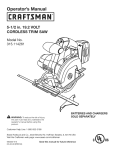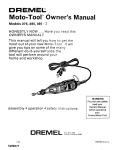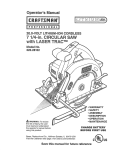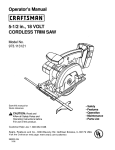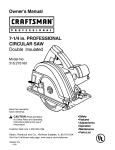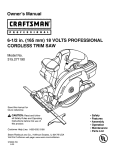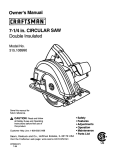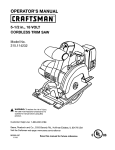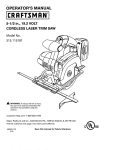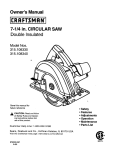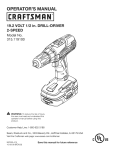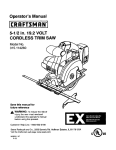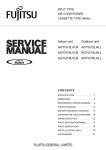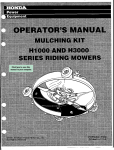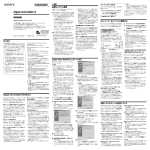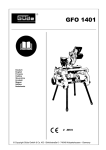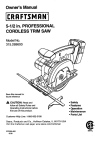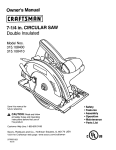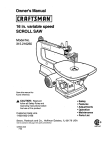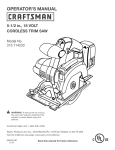Download PERATOR`S MAN AL
Transcript
PERATOR'S MAN T$ AL ® 5-1/2 in., 19.2 VOLT CORDLESS LASER TRiM SAW Model No. 315.115780 BATTERIES AND CHARGERS SOLD SEPARATELY _1_ WARNING: To reduce the risk of injury, the user must read and understand the operator's manual before using this product. Customer Help Line: 1-800-932-3188 Sears, Roebuck and Co., 3333 Beverly Rd., Hoffman Estates, IL 60179 Visit the Craftsman web page: www.sears.com/craftsman 983000-877 02-29-08 (REV:01) Save this manual for future USA C reference [] Warranty ........................................................................................................................................................................... 2 [] Introduction ...................................................................................................................................................................... 2 [] General Safety Rules ..................................................................................................................................................... 3-4 [] Specific Safety Rules ..................................................................................................................................................... 4-5 [] Symbols ......................................................................................................................................................................... 6-7 [] Features ......................................................................................................................................................................... 8-9 [] Assembly ..................................................................................................................................................................... 9-11 [] Operation ................................................................................................................................................................... 12-20 [] Adjustments .................................................................................................................................................................... 20 [] Maintenance .............................................................................................................................................................. 21-22 [] Accessories .................................................................................................................................................................... 22 [] Exploded View and Repair Parts List ........................................................................................................................ 23-24 [] Parts Ordering/Service ..................................................................................................................................... ONE-YEAR FULL WARRANTY ON CRAFTSMAN Back Page TOOL If this Craftsman tool fails to give complete satisfaction within one year from date of purchase, RETURN iT TO ANY SEARS STORE OR OTHER CRAFTSMAN OUTLET iN THE UNITED STATES FOR FREE REPLACEMENT. If this Craftsman tool is used for commercial purchase. or rental purposes, this warranty applies for only 90 days from the date of This warranty gives you specific legal rights, and you may also have other rights which vary from state to state. Sears, Roebuck and Co., Dept. 817 WA, Hoffrnan Estates, IL 60179 This tool has many features for making its use more pleasant and enjoyable. Safety, performance, have been given top priority in the design of this product making it easy to maintain and operate. A and dependability WARNING: Some dust created by power sanding, sawing, grinding, drilling, and other construction activities contains chemicals known to cause cancer, birth defects or other reproductive harm. Some examples of these chemicals are: • lead from lead-based paints, • crystalline silica from bricks and cement and other masonry products, and • arsenic and chromium from chemically-treated lumber. Your risk from these exposures varies, depending on how often you do this type of work. To reduce your exposure to these chemicals: work in a well ventilated area, and work with approved safety equipment, such as those dust masks that are specially designed to filter out microscopic particles. A WARNING! READ AND UNDERSTAND ALL INSTRUCTIONS. Failure to follow all instructions listed below, may result in electric shock, fire and/or serious personal injury. SAVE THESE INSTRUCTIONS WORK AREA [] Keep your work area clean and well lit. Cluttered benches and dark areas invite accidents. [] Do not operate power tools in explosive atmospheres, such as in the presence of flammable liquids, gases, or dust. Power tools create sparks which may ignite the dust or fumes. [] Keep bystanders, children, and visitors away while operating a power tool. Distractions can cause you to lose control. ELECTRICAL SAFETY [] A battery operated tool with integral batteries or a separate battery pack must be recharged only with the specified charger for the battery. A charger that may be suitable for one type of battery may create a risk of fire when used with another battery. [] Use battery operated tool only with specifically designated battery pack. Use of any other batteries may create a risk of fire. [] Use battery only with charger MODEL 315.115780 BATTERY PACK 130279003 130279005 (item No. 911375) PERSONAL listed. CHARGER Model No. 1425301 (item No. 911041) Model No. 315.115730 (item No. 140301003) SAFETY [] Stay alert, watch what you are doing and use common sense when operating a power tool. Do not use tool while tired or under the influence of drugs, alcohol, or medication. A moment of inattention while operating power tools may result in serious personal injury. [] Dress properly. Do not wear loose clothing or jewelry. Contain long hair. Keep your hair, clothing, and gloves away from moving parts. Loose clothes, jewelry, or long hair can be caught in moving parts. [] Avoid accidental starting. Be sure switch is in the locked or off position before inserting battery pack. Carrying tools with your finger on the switch or inserting the battery pack into a tool with the switch on invites accidents. [] Remove adjusting keys or wrenches before turning the tool on. A wrench or a key that is left attached to a rotating part of the tool may result in personal injury. [] Do not overreach. Keep proper footing and balance at all times. Proper footing and balance enable better control of the tool in unexpected situations. [] Use safety equipment. Always wear eye protection. Dust mask, non-skid safety shoes, hard hat, or hearing protection must be used for appropriate conditions. [] Do not wear loose clothing or jewelry. Contain long hair. Loose clothes, jewelry, or long hair can be drawn into air vents. [] Do not use on a ladder or unstable support. Stable footing on a solid surface enables better control of the tool in unexpected situations. TOOL USE AND CARE [] Use clamps or other practical way to secure and support the workpiece to a stable platform. Holding the work by hand or against your body is unstable and may lead to loss of control. [] Do not force tool Use the correct tool for your application. The correct tool will do the job better and safer at the rate for which it is designed. [] Do not use tool if switch does not turn it on or off. A tool that cannot be controlled with the switch is dangerous and must be repaired. [] Disconnect battery pack from tool or place the switch in the locked or off position before making any adjustments, changing accessories, or storing the tool. Such preventive safety measures reduce the risk of starting the tool accidentally. [] Store idle tools out of reach of children and other untrained persons. Tools are dangerous in the hands of untrained users. [] When battery pack is not in use, keep it away from other metal objects like: paper clips, coins, keys, nails, screws, or other small metal objects that can make a connection from one terminal to another. Shorting the battery terminals together may cause sparks, burns, or a fire. [] Maintain tools with care. Keep cutting tools sharp and clean. Properly maintained tools with sharp cutting edges are less likely to bind and are easier to control. [] Check for misalignment or binding of moving parts, breakage of parts, and any other condition that may affect the tool's operation. If damaged, have the tool serviced before using. Many accidents are caused by poorly maintained tools. [] Use only accessories that are recommended by the manufacturer for your model. Accessories that may be suitable for one tool may create a risk of injury when used on another tool. [] Keep the tool and its handle dry, clean and free from oil and grease. Always use a clean cloth when cleaning. Never use brake fluids, gasoline, petroleumbased products, or any strong solvents to clean your tool. Following this rule will reduce the risk of loss of control and deterioration of the enclosure plastic. SERVICE [] Tool service must be performed only by qualified repair personnel. Service or maintenance performed by unqualified personnel may result in a risk of injury, [] When servicing a tool, use only identical replace- ment parts. Follow instructions in the Maintenance section of this manual. Use of unauthorized parts or failure to follow Maintenance Instructions may create a risk of shock or injury. [] DANGER! Keep hands away from cutting area and blade. Keep your second hand on auxiliary handle or motor housing. If both hands are holding the saw, they cannot be cut by the blade. [] Always use blades with correct size and shape (diamond vs. round) arbor holes. Blades that do not match the mounting hardware of the saw will run eccentrically, causing loss of control. [] Keep your body positioned to either side of the saw blade, but not in line with the saw blade. KICKBACK could cause the saw to jump backwards. (see KICKBACK) [] Never use damaged or incorrect blade washers or bolts. The blade washers and bolt were specially designed for your saw, for optimum performance and safety of operation. [] Do not reach underneath the work. The guard cannot protect you from the blade below the work. [] Check the lower guard for proper closing before each use. Do not operate saw if lower guard does not move freely and close instantly. Never clamp or tie the lower guard into the open position, if saw is accidentally dropped, lower guard may be bent. Raise the lower guard with the retracting handle and make sure it moves freely and does not touch the blade or any other part, in all angles and depths of cut. [] Check the operation and condition of the lower guard spring, if the guard and the spring are not operating properly, they must be serviced before use. Lower guard may operate sluggishly due to damaged parts, gummy deposits, or a buildup of debris. [] Lower guard should be retracted manually only for special cuts such as "Pocket Cuts" and "Compound Cuts". Raise lower guard by Retracting Handle. As soon as blade enters the material, lower guard must be released. For all other sawing, the lower guard should operate automatically. [] Always observe that the lower guard is covering the blade before placing saw down on bench or floor. An unprotected, coasting blade will cause the saw to walk backwards, cutting whatever is in its path. Be aware of the time it takes for the blade to stop after switch is released. [] NEVER hold piece being cut in your hands or across your leg. It is important to support the work properly to minimize body exposure, blade binding, or loss of control. [] Hold tool by insulated gripping surfaces when performing an operation where the cutting tool may contact hidden wiring. Contact with a "live" wire will also make exposed metal parts of the tool "live" and shock the operator. [] When ripping always use a rip fence or straight edge guide. This improves the accuracy of cut and reduces the chance of blade binding. Causes and Operator Prevention of Kickback: Kickback is a sudden reaction to a pinched, bound, or misaligned saw blade, causing an uncontrolled saw to lift up and out of the workpiece toward the operator. When the blade is pinched or bound tightly by the kerr closing down, the blade stalls and the motor reaction drives the unit rapidly back toward the operator. If the blade becomes twisted or misallgned in the cut, the teeth at the back edge of the blade can dig into the top surface of the wood causing the blade to climb out of the kerr and jump back toward the operator. Kickback is a result of tool misuse and/or incorrect operating procedures or conditions and can be avoided by taking proper precautions as given below: [] Maintain a firm grip on the saw and position your body and arm in a way that allows you to resist KICKBACK forces. KICKBACK forces can be controlled by the operator, if proper precautions are taken. [] When blade is binding, or when interrupting a cut for any reason, release the trigger and hold the saw motionless in the material until the blade comes to a complete stop. Never attempt to remove the saw from the work or pull the saw backward while the blade is in motion or KICKBACK may occur. Investigate and take corrective actions to eliminate the cause of blade binding. [] When restarting a saw in the workpiece, center the saw blade in the kerf and check that teeth are not engaged into the material. If saw blade is binding, it may walk up or KICKBACK from the workpiece as the saw is restarted. [] Support large panels to minimize the risk of blade pinching and KICKBACK. Large panels tend to sag under their own weight. Supports must be placed under the panel on both sides, near the line of cut and near the edge of the panel. [] Do not use dull or damaged blade. Unsharpened or improperly set blades produce narrow kerf causing excessive friction, blade binding, and KICKBACK. [] Do not charge battery tool in a damp or wet location. Following this rule will reduce the risk of electric shock. [] Blade depth and bevel adjusting locking levers must be tight and secure before making cut. If blade adjustment shifts while cutting, it will cause binding and KICKBACK. [] Use extra caution when making a "Pocket Cut" into existing walls or other blind areas. The protruding blade may cut objects that can cause KICKBACK. [] Know your power tool. Read operator's manual carefully. Learn its applications and limitations, as well as the specific potential hazards related to this tool. Following this rule will reduce the risk of electric shock, fire, or serious injury. [] For best results, your battery tool should be charged in a location where the temperature is more than 50°F but less than 100°F. Do not store outside or in vehicles. [] Always wear safety glasses with side shields. Everyday glasses have only impact resistant lenses. They are NOT safety glasses. Following this rule will reduce the risk of eye injury. Laser Guide Warnings: [] Battery tools do not have to be plugged into an electrical outlet; therefore, they are always in operating condition. Be aware of possible hazards when not using your battery tool or when changing accessories. Following this rule will reduce the risk of electric shock, fire, or serious personal injury. [] Do not place battery tools or their batteries near fire or heat. This will reduce the risk of explosion and possibly injury. [] Do not crush, drop or damage battery pack. Do not use a battery pack or charger that has been dropped or received a sharp blow. A damaged battery is subject to explosion. Properly dispose of a dropped or damaged battery immediately. [] Batteries can explode in the presence of a source of ignition, such as a pilot light. To reduce the risk of serious personal injury, never use any cordless product in the presence of open flame. An exploded battery can propel debris and chemicals. If exposed, flush with water immediately. [] Under extreme usage or temperature condi= tions, battery leakage may occur. If liquid comes in contact with your skin, wash immediately with soap and water, then neutralize with lemon juice or vinegar. If liquid gets into your eyes, flush them with clean water for at least 10 minutes, then seek immediate medical attention. Following this rule will reduce the risk of serious personal injury. The laser guide radiation used in the Craftsman trim saw is Class Ilia with maximum <5 mW and 650nm wavelengths or Class II, <1 mW max, 650nm. These lasers do not normally present an optical hazard although staring at the beam may cause flash blindness. [] Avoid direct eye exposure when using the laser guide. [] The laser shall be used and maintained in accordance with the manufacturer's instructions. [] Never aim the beam at a person or object other than the workpiece. [] Always ensure the laser beam is aimed at a sturdy workpiece without reflective surfaces. Shiny reflective sheet metal or similar shiny materials are not suitable for laser use. [] All repairs should be made by an authorized representative or the laser manufacturer. service Someofthe followingsymbolsmaybeusedonthisproduct.Pleasestudythemandlearntheirmeaning.Properinterpretationofthesesymbolswillallowyouto operatethe productbetterandsafer. SYMBOL DESIGNATION/EXPLANATION V Volts Voltage A Amperes Current mz Hertz Frequency (cycles per second) W Watt Power min Minutes Time Alternating Current Type of current Direct Current Type or a characteristic no No Load Speed Rotational speed, at no load [] Class II Tool Double-insulated .../min Per Minute Revolutions, strokes, surface speed, orbits etc., per minute @ Wet Conditions Alert Do not expose to rain or use in damp locations. Read The Operator's Manual To reduce the risk of injury, user must read and understand operator's manual before using this product. Eye Protection Always wear safety goggles or safety glasses with side shields and, as necessary, a full face shield when operating this product. Safety Alert Precautions that involve your safety. No Hands Symbol Failure to keep your hands away from the blade will result in serious personal injury. No Hands Symbol Failure to keep your hands away from the blade will result in serious personal injury. No Hands Symbol Failure to keep your hands away from the blade will result in serious personal injury. No Hands Symbol Failure to keep your hands away from the blade will result in serious personal injury. Hot Surface To reduce the risk of injury or damage, avoid contact with any hot surface. @ O ,& @ @ @ n NAME ® of current construction Thefollowingsignalwordsandmeanings areintendedto explainthelevelsofriskassociated withthisproduct. SYMBOL SIGNAL MEANING DANGER: Indicates an imminently hazardous situation, which, if not avoided, will result in death or serious injury. WARNING: Indicates a potentially hazardous situation, which, if not avoided, could result in death or serious injury. CAUTION: Indicates a potentially hazardous result in minor or moderate injury.situation, which, if not avoided, may CAUTION: (Without Safety Alert Symbol) Indicates a situation that may result in property damage. = SERVICE ,_ Servicing requires extreme care and knowledge and should be performed only by a qualified service technician. For service we suggest you return the product to your nearest SEARS PARTS AND REPAIR SERVICE CENTER for repair. When servicing, use only identical replacement parts. ,_ WARNING: To avoid serious personal injury, do not attempt to use this product until you read thoroughly and understand completely the operator's manual. If you do not understand the warnings and instructions in the operator's manual, do not use this product. Call the Craftsman Consumer Helpline at 1-800-932-3188 for assistance. WARNING: The operation of any power tool can result in foreign objects being thrown into your eyes, which can result in severe eye damage. Before beginning power tool operation, always wear safety goggles or safety glasses with side shields and, when needed, a full face shield. We recommend Wide Vision Safety Mask for use over eyeglasses or standard safety glasses with side shields. Always use eye protection which is marked to comply with ANSI Z87.1. SAVE THESE INSTRUCTIONS PRODUCT SPECiFiCATiONS Motor ....................................................................................................................................................................... Blade Diameter ........................................................................................................................................................... Blade Arbor ...................................................................................................................................................... Cutting Depth at 0°................................................................................................................................................... Cutting Depth at 45 °................................................................................................................................................... 19.2 V DC 5-1/2 in. 10 mm (3/8 in.) 1-9/16 in. 1-1/8 in. No Load Speed ......................................................................................................................................... 4,500 r/min. (RPM) Laser Guide ......................................................................... Class Ilia, <5 mW max, 650nm or Class II, <1 mW max, 650nm SPINDLELOCK BUTTON LOCK-OFF BUTTON SWITCH TRIGGER LASERGUIDE LASERGUIDE SWITCH EDGEGUIDE SCREW (WING SCREW) UPPER BLADEGUARD LOWERBLADE GUARDHANDLE LOWER BLADEGUARD BEVELCUTADJUSTMENT (BEVELADJUSTMENTKNOB) BASE ASSEMBLY BLADEWRENCH STOBAGEAREA EDGEGUIDE BLADEWRENCH (5 mm HEXKEY) DEPTH OF CUT ADJUSTMENT (DEPTH ADJUSTMENT KNOB) Fig.1 KNOW YOUR LASER TRIM SAW DEPTH CUT See Figure 1, Adjusts the depth of cut from 0 in. to 1-9/16 in. The safe use of this product requires an understanding of the information on the tool and in this operator's manual as well as a knowledge of the project you are attempting. Before use of this product, familiarize yourself with all operating features and safety rules. SPINDLE NOTE: Do not run trim saw with spindle lock engaged. DUST CHUTE EDGE GUIDE Edge guide is used when making long or wide rip cuts with the saw. SWITCH LOCK The spindle lock allows you to secure the blade when turning the blade screw. TRIGGER The trim saw is equipped with a pre-travel safety switch which reduces the possibility of accidental starting. When you depress the switch, the saw will not start until you reach the pre-travel position. You must depress the switch fully to activate the saw. To direct saw dust and chips away from the operator, a dust chute is located on the side of the upper blade guard. ERGONOMIC DESIGN The design of the trim saw provides for maintaining proper two hand control when cutting. It has been designed to be comfortable and easy to grasp. LASER GUIDE Convenient wrench storage for quick blade changes. The laser guide will generate a red line on the work surface when turned on to aid in alignment. UNPACKING ,_ WARNING: If any parts are damaged or missing do not operate the tool until the damaged or missing parts are replaced. Failure to do so could result in possible serious personal injury. _, WARNING: Do not attempt to modify this tool or create accessories not recommended for use with this tool. Any such alteration or modification is misuse and could result in a hazardous condition leading to possible serious personal injury. A_, WARNING: To prevent accidental starting that could cause serious personal injury, always remove the battery pack from the tool when assembling parts. BLADE WRENCH STORAGE This product requires assembly. [] Carefully remove the tool and accessories from the box. Make sure that all items listed in the packing list are included. [] Inspect the tool carefully to make sure no breakage or damage occurred during shipping. [] Do not discard the packing material until you have carefully inspected and satisfactorily operated the tool. [] If any parts are damaged or missing, please call 1-800-932-3188 for assistance. PACKING LIST Cordless Trim Saw with Laser 5-1/2 in. Blade Laser Guide Batteries (2) Edge Guide Blade Wrench Operator's Manual ATTACHING BLADE [] Depress spindle lock button, then replace blade screw. Tighten blade screw securely. See Figure 2. A NOTE: Turn blade screw counterclockwise WARNING: A 5-1/2 in. blade is the maximum blade capacity of the saw. Never use a blade that is too thick to allow outer blade washer to engage with the flats on the spindle. Larger blades will come in contact with the blade guard, while thicker blades will prevent blade screw from securing blade on spindle. Either of these situations could result in a serious accident. to tighten. [] Return blade wrench to storage area. NOTE: Never use a blade that is too thick to allow the outer blade washer to engage with the flats on the spindle. SPINDLE LOCKBUTTON LOWERBLADE GUARDHANDLE [] Locate latches on side of battery pack and depress to release battery pack from the saw. [] Remove blade wrench (5 mm hex key) from storage area. [] Depress spindle lock button and remove blade screw and outer blade washer. BLADE NOTE: Turn blade screw clockwise to remove. [] Wipe a drop of oil onto inner blade washer and outer blade washer where they contact blade. A AlL WARNING: If inner blade washer has been removed, replace it before placing blade on spindle. Failure to do so could cause an accident since blade INNER BLADEWASHER will not tighten properly. OUTER BLADEWASHER [] Fit saw blade inside lower blade guard and onto spindle. NOTE: The saw teeth point upward at the front of saw as shown in figure 2. Fig. 2 [] Replace outer blade washer. 10 REMOVING BLADE SPINDLELOCK See Figure 3, [] Remove battery pack from saw. [] Remove blade wrench from storage area. [] Position saw as shown in figure 3, depress spindle lock button, and remove blade screw. NOTE: Turn blade screw clockwise to remove. SPINDLELOCK SCREW [] Remove outer blade washer. NOTE: Blade can be removed at this point. A WARNING: Do not use any attachments or accessories not recommended by the manufacturer of this tool. The use of attachments or accessories not recommended injury. \ can result in serious personal LOWER BLADE GUARD LEVER TO TIGHTEN EDGE GUIDE Use the edge guide provided with the saw when making wide rip cuts. A five inch scale has been provided on the edge guide. When using the width of cut scale on the base in combination with the edge guide, cuts can be made up to 6 in. to the left of the edge guide or 8-7/8 in. to the right of the edge guide. Fig. 3 The edge guide helps prevent the blade from twisting in a cut. The blade twisting in a cut can cause kickback. INSTALLING EDGE GUIDE EDGE GUIDESCREW (WING SCREW) See Figure 4, [] Remove battery pack from saw. [] Place edge guide through slots in saw base. [] Adjust edge guide to the width needed. [] Tighten edge guide screw (wing screw) securely. NOTE: When using an edge guide, position the face of the edge guide firmly against the edge of workpiece. This makes for a true cut without pinching the blade. The guiding edge of workpiece must be straight for the cut to be straight. Use caution to prevent the blade from binding in the cut. EDGEGUIDE PLACEEDGE GUIDETHROUGHHOLES Fig. 4 11 A A WARNING: Do not allow familiarity with tools to make you careless. Remember that a careless fraction of a second is sufficient to inflict serious injury. WARNING: Always wear safety goggles or safety glasses with side shields when operating tools. Failure to do so could result in objects being thrown into your eyes, resulting in possible serious injury. LATCHES / APPLICATIONS You may use this tool for the following purposes: [] Cutting all types of wood products (lumber, plywood, paneling) [] Cross Cutting/Rip [] Bevel Cutting BATTERYPACK Cutting Fig. 5 [] Pocket Cutting INSTALLING BATTERY REMOVING BATTERY PACK See Figure 6. PACK [] Locate latches on side of battery pack and depress to release battery pack from the saw. See Figure 5. [] Place battery pack in the saw. Align raised rib on battery pack with groove inside saw, then slide battery pack in saw. [] Remove battery pack from the saw. [] Make sure the latches on each side of the battery pack snap into place and battery pack is secured in saw before beginning operation. DEPRESSLATCHESTO BATTERY TO REMOVE CAUTION: When placing battery pack in the saw, be sure raised rib on battery pack aligns with groove inside saw and latches snap into place properly. Improper assembly can cause damage to saw and battery pack. TO INSTALL LATCHES BATTERYPACK Fig. 6 12 KICKBACK See Figures 7- 10. Kickback occurs when the blade stalls rapidly and the saw is driven back toward you. Blade stalling is caused by any action which pinches the blade in the wood. A J_ DANGER: Release switch immediately if blade binds or saw stalls. Kickback could cause you to lose control of the saw. Loss of control can lead to serious injury. To guard against kickback, avoid dangerous practices such as the following: [] Setting blade depth incorrectly. INCORRECTSUPPORT [] Sawing into knots or nails in workpiece. Fig. 8 [] Twisting the blade while making a cut. [] Making a cut with a dull, gummed up, or improperly set blade. [] Supporting the workpiece incorrectly. [] Forcing a cut. [] Cutting warped or wet lumber. [] Operating the tool incorrectly or misusing the tool. To lessen the chance of kickback, practices: follow these safety [] Keep blade at the correct depth setting. The depth setting should not exceed 1/4 in. below the material being cut. [] Inspect the workpiece for knots or nails before cutting. Never saw into a knot or nail. [] Make straight cuts. Always use a straight edge guide when rip cutting. This helps prevent twisting the blade. [] Use clean, sharp, and properly set blades. Never make cuts with dull blades. CORRECTBLADEDEPTHSETTING= BLADEEXPOSEDONEBLADETOOTH BELOWTHE MATERIALTOBECUT Fig. 9 [] Support the workpiece properly before beginning a cut. [] Use steady, even pressure when making a cut. Never force a cut. [] Do not cut warped or wet lumber. [] Hold the saw firmly with both hands and keep your body in a balanced position so as to resist the forces if _kickback should occur. WARNING: When using the saw, always stay alert and exercise control. Do not remove the saw from the workpiece while the blade is moving. CORRECTSUPPORT BLADESETTOODEEP Fig. 7 13 Fig. 10 SAWBLADES Thebestofsawbladeswill notcutefficientlyiftheyare not keptclean,sharp,andproperlyset.Usinga dullblade willplacea heavyloadonthesawandincrease the dangerof kickback.Keepextrabladesonhand,sothatsharp bladesarealwaysavailable. Gumandwoodpitchhardenedonbladeswillslowthe sawdown.Removesawbladefromthesawandusegum andpitchremover, hotwater,or kerosene to removethese accumulations. DO NOT USE GASOLINE. BLADE GUARD See Figure 11. STARTING/STOPPING To start the saw: Depress the switch trigger. Always let the blade reach full speed, then guide the saw into the workpiece. WARNING: SYSTEM To stop the saw: Release the switch trigger. After you release the switch trigger, allow the blade to come to a complete stop. Do not remove the saw from the workpiece while the blade is moving. SWITCH TRIGGER DANGER: When sawing through work, lower blade guard does not cover blade on the underside of work. Since blade is exposed on underside of work, keep hands and fingers away from cutting area. Any part of your body coming in contact with moving blade will result in serious injury. CAUTION: Never use saw when guard is not operating correctly. Check the guard for correct operation before each use. The guard is operating correctly when it moves freely and readily returns to the closed position. If you drop the saw, check the lower blade guard and bumper for damage at all depth settings before reuse. LOWERBLADEGUARD IS IN UP POSiTiON WHEN MAKINGA CUT BLADEEXPOSEDON UNDERSIDEOFWORKPIECE The blade coming in contact with the workpiece before it reaches full speed could cause the saw to "kickback" toward you resulting in serious injury. The lower blade guard attached to the trim saw is there for your protection and safety. Do not alter it for any reason. If it becomes damaged, do not operate the saw until you have the guard repaired or replaced. Always leave guard in operating position when using the saw. _IL THE SAW See Figure 12. Fig. 11 14 A WARNING: Always remove battery pack from the tool when changing operation settings or when the tool is not in use. Failure to remove the battery pack may result in accidental starting and serious personal injury. ADJUSTING BLADE TO RAISE SAW DEPTH See Figure 13. Always keep correct blade depth setting. The correct blade depth setting for all cuts should not exceed 1/4 in. below the material being cut. More blade depth will increase the chance of kickback and cause the cut to be rough. For more depth of cut accuracy, a scale is located on the upper blade guard. BASE ASSEMBLY TO LOWERSAW TO [] Remove battery pack from saw. [] Loosen depth adjustment knob. [] Determine the desired depth of cut. TO DEPTH ADJUSTMENT LOOSEN KNOB Fig. 13 [] Locate depth of cut scale on back of upper blade guard. [] Hold base flat against the workpiece and raise or lower saw until the indicator mark on bracket aligns with notch on blade guard. DEPRESSLASER (ON/OFF) [] Tighten depth adjustment knob securely. ,h USING TIGHTEN LASERGUIDE THE LASER GUIDE See Figure 14 _IL GUIDESWITCH WARNING: Do not stare into the laser beam or turn the laser on when the tool is not in use. Failure to do so could result in possible serious personal injury. The laser unit comes from the factory already installed and aligned. If the laser becomes misaligned after time refer to the "Adjustments" section. NOTE: Make a trial cut on a piece of scrap material to ensure laser is aligned; adjusting the laser may be necessary. [] Remove battery pack from saw [] Mark the line to be cut on the workpiece. [] Adjust the depth and angle of the cut as needed. [] Switch on the laser beam. [] Install battery pack into the tool and start the motor. NOTE: Do not touch the blade to the workpiece until the saw has reached maximum speed. [] Slowly push the saw forward into the workpiece. Fig. 14 NOTE: Keep the laser beam on the marked line on the workpiece for precision cutting. [] Once the cut is complete, allow the saw to come to a complete stop before turning off the laser. [] Remove battery pack from saw. 15 OPERATINGTHE SAW See Figures 15- 17. It is important to understand the correct method for operating the saw. Refer to the figures in this section to learn the correct and incorrect ways for handling the saw. A A DANGER: When lifting the saw from the workpiece, the blade is exposed on the underside of the saw until the lower blade guard closes. Make sure the lower blade guard is closed before setting the saw down. WARNING: To make sawing easier and safer, always maintain proper control of the saw. Loss of control could cause an accident resulting in possible serious injury. To make the best possible cut, follow these helpful hints. [] Hold the saw firmly with both hands. CORRECT [] Avoid placing your hand on the workpiece while making a cut. Fig. 16 [] Support the workpiece so that the cut (kerf) is always to your side. [] Support the workpiece near the cut. [] Clamp the workpiece securely so that the workpiece will not move during the cut. [] Always place the saw on the workpiece that is supported, not the "cut off" piece. [] Place the workpiece with the "good" side down. [] Draw a guideline along the desired line of cut before beginning the cut. // / I\ WRONG WRONG Fig. 15 16 Fig. 17 CROSSCUTTING/RIPCUTTING WORKPIECE See Figure 18. NOTE: Refer to "Using the Laser Guide" on page 19 for the following aplications When making a cross cut or rip cut, align the line of cut with the outer blade guide notch on the base as shown in the figure. Since blade thicknesses vary, always make a trial cut in scrap material along a guideline to determine how much, if any, you must offset the guideline to produce an accurate cut. NOTE: The distance from the line of cut to the guideline is the amount you should offset the guide. TOP ViEW OF SAW BLADE GUIDENOTCH GUiDELiNE NOTE:C-CLAMP BOTHENDS OFSTRAIGHT EDGEBEFOREMAKINGCUT STRAIGHT EDGE Fig. 19 TO RIP CUT WITH EDGE GUIDE See Figure 20. [] Secure the workpiece. [] Position the face of the edge guide firmly against the edge of workpiece. [] Guide the saw along the edge to achieve a straight rip cut. NOTE: The guiding edge of the workpiece must be straight for the cut to be straight. Use caution to prevent the blade from binding in the cut. ALIGNOUTERBLADEGUIDENOTCHON SAWBASEWiTH LINE OFCUTAS SHOWNWHENMAKINGCROSSCUTSORRiP CUTS Fig. 18 TO RIP CUT WITHOUT EDGE GUIDE See Figure 19. Use a guide when making long or wide rip cuts with the saw. [] Secure the workpiece. [] Clamp a straight edge to the workpiece using C-clamps. [] Saw along the straight edge to achieve a straight rip cut. NOTE: Do not bind the blade in the cut. WORKPIECE GUiDELiNE EDGEGUIDE Fig. 20 17 BEVELCUTTING BEVEL SCALE See Figures 21 - 23. NOTE: Refer to "Using the Laser Guide" on page 19 for the following aplications BEVEL ADJUSTMENT KNOB To make the best possible cut, follow these helpful hints: [] Align the line of cut with the inner blade guide notch on the base when making 45 ° bevel cuts. [] Make a trial cut in scrap material along a guideline to determine how much you should offset the guideline on the cutting material. [] Adjust the angle of the cut to any desired setting between zero and 51.5 ° . Refer to "To Adjust Bevel Setting" next. BLADEGUIDE NOTCH NOTE: When making bevel cuts, you may need to re-adjust laser (See "Adjusting the Laser.") Fig. 21 TO ADJUST BEVEL SETTING BEVEL ADJUSTMENT See Figure 22. [] Remove battery pack from the trim saw. [] Loosen bevel adjustment knob. [] Raise motor housing end of saw until you reach desired angle setting on bevel scale. [] Tighten bevel adjustment knob securely. _, WARNING: Attempting a bevel cut without having the bevel adjustment knob securely tightened can result in serious injury. BEVEL SCALE / TO BEVEL CUT See Figure 23. BLADE GUIDE NOTCH [] Hold the saw firmly with both hands as shown. / GUiDELiNE [] Rest the front edge of the base on the workpiece. [] Start the saw and let the blade reach full speed. ALIGN iNNERBLADEGUIDENOTCHONSAW BASEWITH LiNEOF CUTAS SHOWNWHENMAKING45° BEVELCUTS [] Guide the saw into the workpiece and make the cut. Fig. 22 [] Release the trigger and allow the blade to come to a complete stop. [] Lift the saw from the workpiece. Fig. 23 18 POSiTiVE0° BEVELSTOP ADJUSTMENT SCREW See Figure 24. BEVEL ADJUSTMENT KNOB The saw has a positive 0 ° bevel stop that has been factory adjusted to assure 0 ° angle of the saw blade when making 90 ° cuts. TO CHECK POSiTiVE 0° BEVEL STOP [] Remove battery pack from the trim saw. [] Place the saw in an upside down position on a workbench. HEX NUT [] Check the squareness of the saw blade to the base of the saw using a carpenter's square. TO ADJUST POSiTiVE 0° BEVEL STOP POSiTiVE0° BEVEL STOP BLADE Follow these directions to adjust the positive 0° bevel stop: [] Remove battery pack from the trim saw. [] Loosen bevel adjustment knob. [] Turn setscrew with hex key and adjust base until it is square with the saw blade. [] Tighten bevel adjustment knob securely. WARNING: CARPENTER'S SQUARE Attempting a bevel cut without having the bevel adjustment knob securely tightened can result in serious injury. Fig. 24 19 POCKETCUTTING [] Release the trigger and allow the blade to come to a complete stop. See Figure 25. _, [] Lift the saw from the workpiece. [] Clear corners out with a hand saw or sabre saw. WARNING: Always adjust bevel setting to zero before making a pocket cut. Attempting a pocket cut at any other setting can result in loss of control of the saw possibly causing serious injury. A [] [] [] [] [] Remove battery pack from saw. Adjust the bevel setting to zero. Set the blade to the correct blade depth setting. Place battery pack in saw. Swing the lower blade guard up using the lower blade guard handle. NOTE: Always raise the lower blade guard with the handle to avoid serious injury. WARNING: Never tie the lower blade guard in a raised position. Leaving the blade exposed could lead to serious injury. [] Hold the lower blade guard by the handle. [] Rest the front of the base flat against the workpiece with the rear of the handle raised so the blade does not touch the workpiece. [] Start the saw and let the blade reach full speed. [] Guide the saw into the workpiece and make the cut. _, A WARNING: Always cut in a forward direction when pocket cutting. Cutting in the reverse direction could cause the saw to climb up on the workpiece and back toward you. LOWERBLADEGUARD POCKETCUT Fig. 25 [] Replace the laser cover. WARNING: Before performing any adjustment, make sure the battery pack is removed from tool. Failure to heed this warning could result in serious personal injury. [] Check for proper alignment. [] Repeat as necessary until laser is aligned. LASERCOVER ADJUSTING THE LASER See Figure 26, NOTE: Draw a pencil line on a scrap workpiece parallel to the long edge of the base as a straight line guide to aid in the adjusting process. SCREW [] Remove battery pack from the trim saw. [] Make sure laser is turned off. [] Remove the laser cover by lifting it off its base. [] Turn laser on. [] Loosen the screw inside laser. [] Rest the front of the base on scrap workpiece. [] Adjust the laser beam with the mark on the scrap workpiece by loosening the screw to the laser aperture and slowly moving laser guide left or right. LONGEDGE OF BASE [] Place battery pack in saw. [] Since blade thicknesses vary, always make a trial cut in scrap workpiece to ensure an accurate cut. [] Once alignment is achieved, tighten the screw. % 20 PENCILLiNE Fig. 26 A A WARNING: When servicing use only identical Craftsman replacement parts. Use of any other parts may create a hazard or cause product damage. Avoid directeyeexposure_ Laser radiation- I Laser radiation_ osure_J I WARNING: Always wear safety goggles or safety glasses with side shields during power tool operation or when blowing dust. If operation is dusty, also wear a dust mask. GENERAL MAINTENANCE Avoid using solvents when cleaning plastic parts. Most plastics are susceptible to damage from various types of commercial solvents and may be damaged by their use. Use clean cloths to remove dirt, dust, oil, grease, etc. _Max0otput __ <1row _ _Wavelength:650om J Complies wilh21CFRpails tN0.10 _nd1N0.11,A_ril 1,2003 Sears, Roebuck and Co., _, WARNING: Do not at any time let brake fluids, TTCS.GA55_ gasoline, petroleum-based products, penetrating oils, etc., come in contact with plastic parts. Chemicals can damage, weaken or destroy plastic which may result in serious personal injury. Electric tools used on fiberglass material, wallboard, spackling compounds, or plaster are subject to accelerated wear and possible premature failure because the fiberglass chips and grindings are highly abrasive to bearings, brushes, commutators, etc. Consequently, we do not recommended using this tool for extended work on these types of materials. However, if you do work with any of these materials, it is extremely important to clean the tool using compressed air. LUBRICATION All of the bearings in this tool are lubricated with a sufficient amount of high grade lubricant for the life of the unit under normal operating conditions. Therefore, no further lubrication is required. REPLACING LASER GUIDE BATTERIES See Figure 27. [] Remove battery pack from saw. [] Make sure the laser is turned off. [] Remove the laser cover by lifting it off its base. [] Remove both AAA batteries. [] Install new AAA batteries, aligning the positives (+) with positives (+) and the negatives (-) with negatives (-) as shown on the inside base of laser. [] Replace the laser cover. [] Turn on the laser. A CAUTION: Use of controls or adjustments for performance other than those specified herein may result in hazardous radiation exposure. Fig. 27 21 BATTERY PACK REMOVAL AND PREPARATION FOR RECYCLING BATTERIES The battery pack for this tool is equipped with nickel-cadmium rechargeable batteries. Length of service from each charging will depend on the type of work you are doing. To preserve natural resources, please recycle or dispose of batteries properly. The batteries in this tool have been designed to provide maximum trouble-free life. However, like all batteries, they will eventually wear out. Do not disassemble battery pack and attempt to replace the batteries. Handling of these batteries, especially when wearing rings and jewelry, could result in a serious burn. This product contains nickel-cadmium batteries. Local, state or federal laws may prohibit disposal of nickelcadmium batteries in ordinary trash. Consult your local waste authority for information regarding available recycling and/or disposal options. To obtain the longest possible battery life, we suggest the following: A [] Remove the battery pack from the charger once it is fully charged and ready for use. For battery pack storage longer than 30 days: [] Store the battery pack where the temperature 80°F. [] Store battery packs in a "discharged" is below condition. WARNING: Upon removal, cover the battery pack's terminals with heavy duty adhesive tape. Do not attempt to destroy or disassemble battery pack or remove any of its components. Nickel-cadmium batteries must be recycled or disposed of properly. Also, never touch both terminals with metal objects and/or body parts as short circuit may result. Keep away from children. Failure to comply with these warnings could result in fire and/or serious injury. Look for these accessories at Sears retail: [] 5-1/2 in. Thin Kerf Blade WARN(NG: Current attachments and accessories available for use with this tool are listed above. Do not use any attachments or accessories not recommended by the manufacturer of this tool. The use of attachments or accessories not recommended can result in serious personal injury. 22 CRAFTSMAN 19.2 VOLT CORDLESS 11 34 TRiM 30 SAW - MODEL NUMBER 315.115780 32 I I I I 12 F 33 | J I I 36 14 31 18 17 S 26 7 9 1 '_ / 19 16 20 23 21 22 35 24 27 2 0 25 ,_ -- CRAFTSMAN 19.2 VOLT CORDLESS TRiM SAW - MODEL NUMBER 315.115780 SEE BACK PAGE FOR PARTS ORDERING iNSTRUCTiONS PARTS LiST KEY NO. Y_ PART NUMBER DESCRiPTiON QTY. 1 6614301 2 3025516 3 6614501 4 5224502 5 680001001 Spring .......................................................... 1 6 520177002 Wing Screw ................................................. 1 7 67974O1 8 6802201 * Lock Nut (M5) .............................................. Hex Nut ........................................................ 2 1 9 6621204 * Screw (M4 X 16 mm Pan Hd.) ..................... 1 10 660142001 * Carriage Bolt (M6 X 12 mm) ........................ 1 11 9427205 Logo Plate ................................................... 1 12 9429817 Warning Label .............................................. 1 13 640556017 Upper Blade Guard ...................................... 1 14 6620803 15 5217802 16 6619302 * Screw (M5 X 15.5 mm) ................................ 1 17 6867201 18 550994005 Torsion Spring .............................................. 1 Lower Blade Guard ....................................... 19 6807001 Ball Bearing (Ntn #6000zz) .......................... 1 20 6850303 Bearing Retainer .......................................... 21 6620104 * Carriage Bolt (M6 X 100 mm) ...................... 1 Base Assembly ............................................ KEY NO. 22 1 1 6112101 Outer Blade Washer .................................... 1 6614401 Blade Screw ................................................ 1 26 67O957OO1 Edge Guide ................................................. 1 27 6800201 28 5228001 Blade Wrench (5 mm Hex Key) .................... 1 Washer ......................................................... 2 29 301014009 Laser Guide Assembly (Class Ilia) ............... 1 * Screw (M6 X 16 mm Hex Hd.) ..................... 1 Knob ............................................................ 2 24 25 301014008 Laser Guide Assembly (Class II) .................. 1 30 660212031 31 940057079 Screw (M4 X 8 mm Washer Hd) ............... Data Plate .................................................... 3 1 32 750273002 Battery ......................................................... 2 33 940214085 Laser Data Plate (Class Ilia) ......................... 1 940214082 Laser Data Plate (Class II)............................ 1 34 940230081 35 680027001 Laser Warning ................................................ Washer ......................................................... 1 36 940304166 Logo Label ................................................... 983000877 Operator's Manual * Screw (M4 X 22 mm Pan Hd.) ..................... 4 1 QTY. Inner Blade Washer ..................................... 23 6112004 DESCRiPTiON Saw Blade ................................................... 1 Bumper ........................................................ PART NUMBER ! * Screw (M2.6 X 10 mm Pan Hd.) .................. 4 * Standard Hardware item - May Be Purchased Locally ** Can Be Purchased Thru RSOS (Retail Special Order System) *** Complete Assortment Available At Your Nearest Sears Retai_ Store 1
























